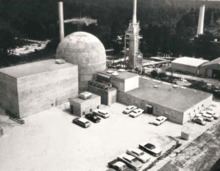Country United States Units decommissioned 1 x 17 MWe Decommission date 10 January 1967 | Status Decommissioned Construction began 1 January 1960 | |
 | ||
Location Fairfield County, near Jenkinsville, South Carolina Operator(s) Carolinas Virginia Nuclear Power Associates Reactor type Pressurised heavy water reactor | ||
Carolinas–Virginia Tube Reactor (CVTR), also known as Parr Nuclear Station, was an experimental pressurized tube heavy water nuclear power reactor at Parr, South Carolina in Fairfield County. It was built and operated by the Carolinas Virginia Nuclear Power Associates.
Contents
Purpose
Construction started on January 1, 1960. The CVTR was built to test the concept of a heavy water moderated and cooled pressurized tube reactor for civilian power. It was the first US heavy water power reactor. It was operated by the Carolinas Virginia Nuclear Power Associates, which was a consortium of the following utilities: Carolina Power & Light Company, Duke Power Company, South Carolina Electric & Gas Company (SCE&G), and Virginia Electric and Power Company
Design
Design of the CVTR began around 1955. CVTR had a thermal output of about 65 MW and a gross electrical output of 19 MW. Westinghouse Atomic Power Division was responsible for the design of the nuclear systems while Stone and Webster Engineering designed the remainder of the plant.
The reactor consisted of 36 vertical U-tube fuel channels in a moderator tank which was 10 feet in diameter and 16 feet tall. Each leg of the U-tube contained one fuel assembly made up of 19 fuel rods. The reactor used enriched uranium; 12 of the tubes contained fuel enriched to 1.5% U-235 and 24 tubes contained fuel enriched to 2% U-235.
During power operation, heavy water was circulated by primary pumps through the U-tubes containing the fuel assemblies which heated the water. The heated water then flowed through an inverted U-tube steam generator where the heat was transferred to the secondary side light water which turned to steam. The steam flowed to an oil-fired superheater which increased the steam quality before the steam entered the turbine which spun the electrical generator. After passing through the steam generator, the primary loop water was pumped back to the reactor by the primary pumps to repeat the cycle. The primary loop heavy water was pressurized to ensure that the heavy water remained liquid and did not flash to steam at any point in the loop.
The U-shaped pressure tubes containing the fuel were thermally isolated from the hot fuel assembly by two circular thermal baffle tubes around the fuel assembly. This allowed the pressure tubes to operate at low temperatures, essentially that of the moderator tank which was maintained about 155 degrees F and close to atmospheric pressure. The moderator tank contained heavy water which moderated the fission process during operation of the reactor.
The CVTR containment design was a new concept at the time; the general design later became the prevalent design for pressurized water reactor containments in the United States. Designed by Stone and Webster Engineering, the design was focused on not allowing any leakage of radioactive gases or material following an accident. The containment design featured a flat concrete foundation, cylindrical walls, and a hemispherical dome, all with an airtight 1/2" or 1/4" (depending on location) steel plate welded liner. The containment was constructed of reinforced concrete. From the basement floor to the interior surface of the top of the dome measured 114’-2”. The vertical walls were 2’-0” thick, the cylindrical structure had an interior diameter of 58’-0”, and the dome had a slightly larger interior radius of 29’-4”.
The reactor and facilities were located at Parr, SC just to the northeast of the existing Parr Reservoir hydroelectric dam across the Broad River on a high bluff that overlooks the dam powerhouse.
Construction
The site for the CVTR was approved by the Atomic Energy Commission’s Advisory Committee on Reactor Safeguards in January 1959. Construction started in 1960.
Operation
The reactor went critical for the first time on March 30, 1963. CVTR operated successfully from 1963 to 1967. It was shut down after the completion of the planned test program.
Test facility use
Following decommissioning of the CVTR, the facility was used for conducting large scale tests to provide experimental information on the response of containment structures to severe events. In the late 1960s, three tests were conducted in which large volumes of steam from the nearby coal-fired power plant was suddenly released into the CVTR Containment and the response of the plant measured. The results of these experiments were later used for the development and validation of computer model codes.
Decommissioning
The CVTR has been decommissioned and its license was withdrawn. No fuel remains onsite. By the Fall of 2009, demolition was complete and the site returned to greenfield.
The much larger and currently operational Virgil C. Summer Nuclear Generating Station was constructed in the 1970s, and began operating in 1984, approximately three miles north of the CVTR.
